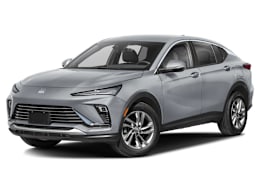The Envista expands the Buick line with a small, stylish subcompact that blends elements of a car and an SUV. This all-new front-wheel-drive model, which replaces the Encore, is the mechanical sibling to the Chevrolet Trax, and both are built in South Korea.
Buyers are likely to appreciate the Envista’s slightly elevated driving position, relatively frugal gas mileage, and the practicality of its hatchback layout. It also shines in terms of features for the money, as our test model included a power driver’s seat, heated front seats, a heated- and wrapped steering wheel, and wireless Android Auto and Apple CarPlay connectivity for just over $25,000.
But although it shows great bang for the buck, the Envista also carries a few compromises. These include a power delivery that can be either hesitant or abrupt, a noisy cabin, uncomfortable front seats, and a cheap interior. We also don’t like that blind spot warning and rear cross traffic warning are extra-cost options, and that highway-speed automatic emergency braking isn’t available. As such, customers who seek a sophisticated driving experience, a luxurious interior, and a comfortable and quiet cabin should look elsewhere.
The Envista’s 1.2-liter turbocharged three-cylinder has both good and bad points. On the one hand, it feels energetic for such a small engine, with ample low-end grunt. It makes the most of its modest 137 horsepower, posting a commendable-for-the-class 9-second 0 to 60 mph time. But we dislike the hesitation when stepping back on the gas pedal during rolling stops, made worse by an uneven burst of power that typically follows. The six-speed automatic transmission isn’t all that smooth nor is it keen to downshift, which keeps the engine at low revs where it sounds and feels rather rough.
Fuel economy of 29 mpg overall is good but not impressive, considering that this is a front-wheel-drive-only model, without the option for all-wheel drive. Some other front-drive small hatchback models, such as the Hyundai Venue, manage 32 mpg overall.
Anyone expecting traditional Buick ride comfort and noise isolation should adjust their expectations. Elevated road noise and the engine’s gritty tone make for a loud cabin. Ride comfort initially seems decent on smoother roads, but bigger bumps or transverse ridges come through with a significant impact. Handling feels mundane because of imprecise steering and a mushy suspension. That’s why we were surprised when the Envista shamed a few sports cars in our avoidance maneuver evaluation with a 58.5 mph speed. It also showed strong stopping prowess in our panic-braking tests.
The Envista’s slightly elevated front-seat height is appealing—higher than sedans, but lower than most SUVs, which makes getting in and out up front pretty easy. There’s decent headroom, but the plastic center console can interfere with the driver’s right knee space, and the armrests are big-time short on padding. We found the front seats to be too firm, with minimal side bolstering, limited thigh support, and scratchy fabric. Our test car’s optional two-way lumbar adjustment for the driver’s seat increases lower-back support on longer trips, but these seats just aren’t all that comfortable.
The rear seat has good kneeroom and foot space under the front seats, but headroom is tight for taller adults and it suffers from limited under-leg support. The hatchback adds cargo-carrying versatility and includes a cover to keep your goods from prying eyes.
In keeping with the low price, the cabin is festooned with lots of black plastic, and it showcases an indifference toward panel gaps. There are token chromelike accents here and there, but they can’t mask the rudimentary interior. For example, the dashboard and seats look better to the eye than they feel to the touch. Admittedly, this is an incremental improvement over what we found in the Trax’s cabin.
Most of the controls are fairly easy to use, and we appreciate that the climate system consists of straightforward dials and buttons. We also like that the Envista comes standard with wireless Android Auto and Apple CarPlay—not a given in this price range. But we found it annoying that you have to go through the infotainment screen to change what’s displayed within the driver’s instrument cluster, and the center display is also the only way to check or reset the trip computer. Typically that’s all within the driver’s screen.
The Envista comes standard with automatic emergency braking with pedestrian detection, lane departure warning, lane keeping assistance, and automatic high beams. It’s disappointing that blind spot warning and rear cross traffic warning are optional, instead of standard, and that automatic emergency braking that operates at highway speeds, and reverse automatic emergency braking, aren’t available at all. Adaptive cruise control is available, but lane centering assistance is not.


























